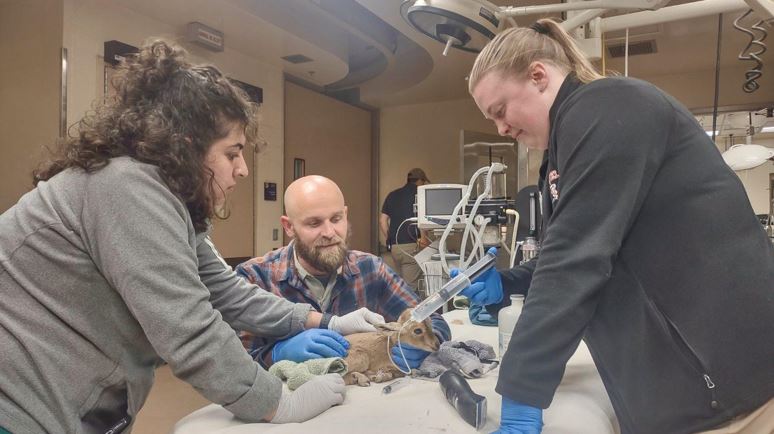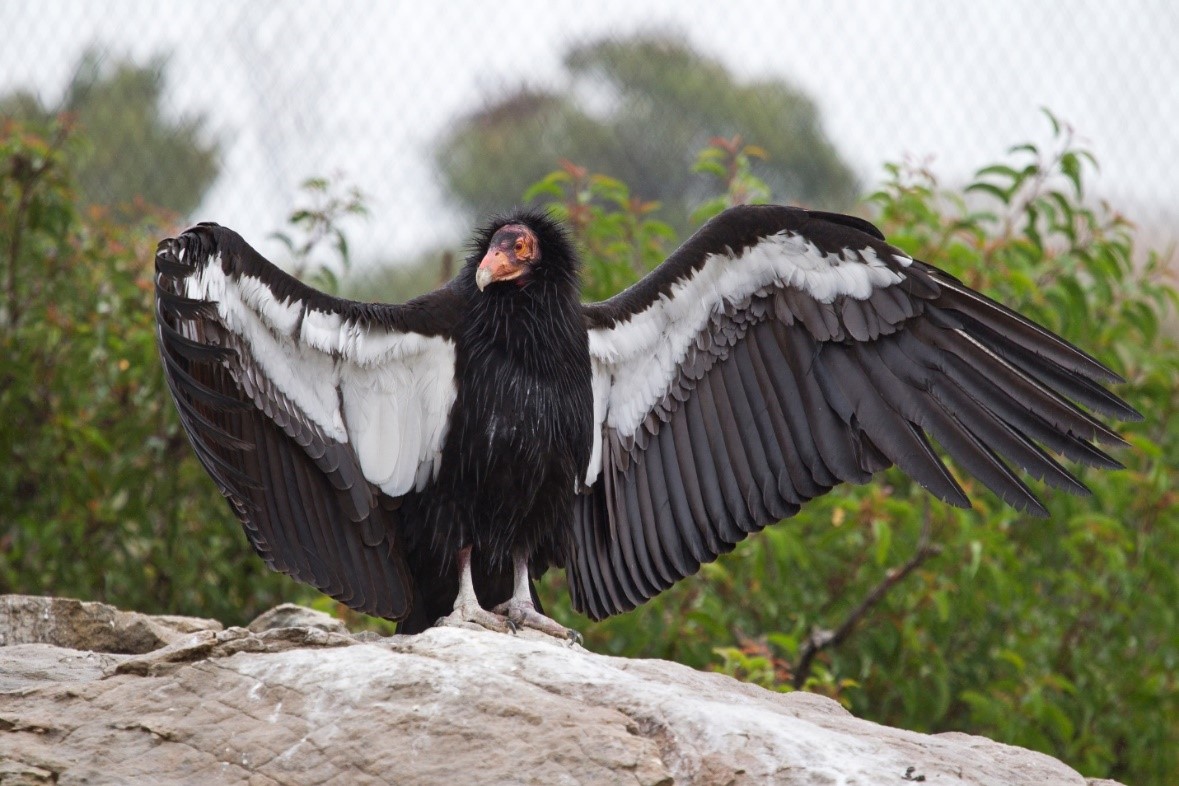An Action-Packed Externship with the San Diego Zoo Wildlife Alliance
By Kaitlyn Trail, Cornell DVM ‘23
Thanks to lifted pandemic restrictions and funding from both the San Diego Zoo Wildlife Alliance and the Cornell Yang Center for Wildlife Health Student Support Fund, I was able to travel to the opposite side of the country for the last six weeks of my clinical year for an externship at the San Diego Zoo Safari Park, an 1,800-acre facility serving as home to more than 3,000 animals representing over 300 species. I remember feeling a volatile mix of excitement and anxiety about the trip as I stepped off the plane. I’d been building-up the idea of a career in zoological medicine in my head for over a decade without setting foot in a zoo hospital. Would reality match my imagination at all?
Of course, most of the images I had created were tempered by experience: daydreams of working hands-on with flagship species all day met the reality of all the hours of non-clinical work (i.e. paperwork) that come with every hour of hands-on medicine in any veterinary field, and especially in fields working with managed and endangered wildlife. Still, while I realized that I’d set a high bar in my mind for this externship to meet, the experience exceeded even my wildest hopes.
Pursuing a career in zoo medicine is a major commitment, and I wanted to pursue this externship to test the waters before fully throwing myself down that path. The Safari Park externship was a wonderful chance to see the full breadth of what zoo work entails.
Enhancing my clinical skills
We focused heavily on individual animal health, but zoo veterinarians, like vets in most other fields, have responsibilities beyond the individual. Addressing population health management for both single species and mixed-species enclosures, as well as tackling species-level health and conservation efforts were common day-to-day activities. The diversity of the work was incredible. I was first drawn to zoo medicine for the variety and challenge of being responsible for so many species, but the range of tasks and issues presented to zoo veterinarians was even wider than I had imagined.
From day one I found myself immersed in clinical work with species I’d only seen on screens before. My introduction to zoo medicine was with a newborn Nubian Ibex that was doing poorly in the field with its mother. The mother was young and had triplets, so she just didn’t have the resources to care for all of them. The smallest, sadly, wasn’t getting the nutrients it needed, so it was brought to the hospital for supportive care before being taken in for hand-rearing. I got to know this little one over the next few weeks as we checked in on it regularly to make sure it continued to thrive.
Action-packed field procedures
My favorite part of veterinary work at the Safari Park is that it doesn’t all happen indoors. Since most of the zoo’s property is comprised of massive enclosures for semi-free-ranging herds, some action has to take place outside, and field procedures quickly won out as my preferred activity at the park. On my second day, we loaded up the trucks and headed out through the backroads of the Safari Park to one of the huge mixed species habitats that are one of the park’s many unique features compared to most other zoos.
The entire experience had a ring of familiarity to it amid all the exciting newness. The huge, modified pickup trucks were the same ones Cornell’s ambulatory service uses to make farm calls, with the truck bed replaced with a Bowie unit designed to hold the many different drugs and tools veterinarians might need to practice medicine on the road. The supplies and drugs we packed into plastic totes and piled into the Bowie were familiar too - as unique as zoo medicine is, many of the tools used are of course are the same.
However, there was nothing familiar about the large Dan-Inject darting rifle loaded into the side compartment of the Bowie, and seeing three trucks of vet staff and equipment driving together in a caravan to the same procedure surprised me. As we made our way through the last of several secure gates to the meeting point, 20 additional members of the zoo’s staff came into view, and the novelty of the experience hit home.
The amount of teamwork required to pull off a field procedure efficiently and safely is extraordinary, and watching it all come together was fascinating. My first field procedure involved relocating two roan antelope to another habitat. The rest of their herd had been caught in catch pens and transported already, but two savvy older females remained behind.
Field anesthesia is an unparalleled opportunity to access a normally untouchable animal, and zoos never waste such chances on only one task. I learned quickly at the Safari Park that if you’re going to “have hands on” an animal, you treat that opportunity like you won’t touch that animal again for at least a year. This means that, while these antelope were healthy individuals and weren’t due for a health check for several months, we would be doing their full health screening, vaccinations, and deworming before loading them into the trailer.
That day, I learned just how much a team can accomplish in thirty minutes of anesthesia time. Twenty people were around the first roan the minute it settled on the ground. Two stabilized its head, several more helped position it for a hoof trim while the vet team moved in with supplies—oxygen, vaccines, blood collection kits, and dewormer. I was teamed up with Kristen, an awesome licensed veterinary technician who helped walk me through collecting blood. It felt like no time at all before we were loading the antelope into a trailer for transport, and preparing for the next one. The whole situation was rather overwhelming at first. With so many people and moving parts, I felt in the way no matter where I stood. But Kristin was great and made sure I was involved in the process. Thanks to her and the rest of the vet team, I soon felt at home in the organized chaos.
Working with species recovery programs
Some of the most rewarding appointments we saw were for animals in the various species recovery programs the Safari Park participates in, including those focused on Pacific pocket mice, northern white rhinoceros, and mountain yellow-legged frogs. My favorite animals were the California condors. The Safari Park participates in breeding and hatching programs, and I was lucky enough to be there in the spring when eggs were hatching and chicks were growing. The condor care team there was so excited to teach about their work with these incredible birds, and they were kind enough to invite some of the vet team out to observe egg checks one day. I learned so much about condor egg incubation, hatching, and chick rearing from them. I even got to participate in health checks on several chicks of different ages, and it was amazing to see how much they grow in just a couple of months!
During my short time on this externship, I got to see everything from new California condor hatchlings, completely helpless and weighing less than half a pound, to chicks at their 75-day health check, nearly the size of a soccer ball and somewhat intimidating despite their fuzzy down and flightless chicken wings. These chicks were being raised with minimal contact with humans so that they could be released into the wild one day. It was incredibly humbling to participate in a tiny part of this well-known and remarkably successful species recovery program.
Final reflections
From dental checks on tiny Pacific pocket mice to lameness evaluations on a giraffe, I saw and participated in it all. And that was the truly exciting part: participating. The fantastic team at the Safari Park were happy to teach, and encouraged hands-on learning whenever they could, whether during a brief visual exam of a healthy animal or on a workup for an anesthetized, sick individual. I had an incredible time continuing to improve my clinical knowledge while gaining experiences unique to zoo medicine.
I’m so grateful to the veterinarians, technicians, and hospital care staff at the Safari Park for their kindness and eagerness to teach. Their encouragement and support made this experience incredibly valuable. My time there was everything I’d hoped for and more, and I left with new knowledge, mentors, and a ton of incredible new memories.
Katie Trail, DVM class of 2023, is a recent graduate of the Cornell University College of Veterinary Medicine. Originally from Oklahoma, she completed her undergraduate degree in chemistry at the University of Oklahoma. Katie is pursuing a zoo medicine career and is currently completing a small animal rotating internship in New Jersey.


